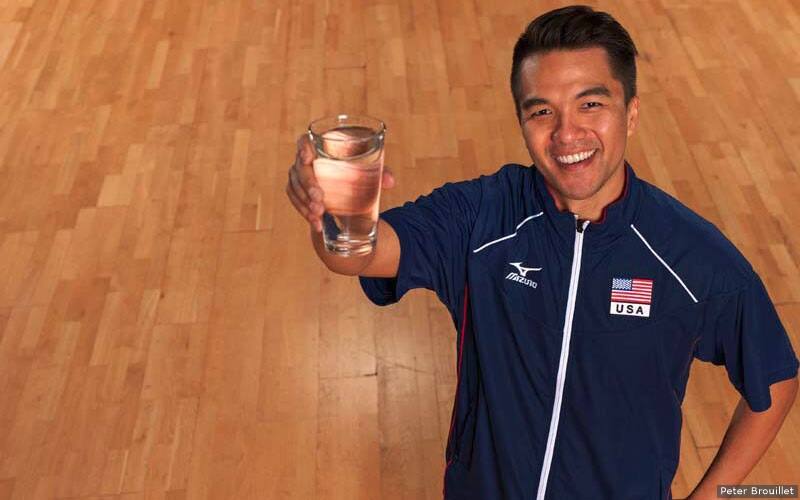
For volleyball players, drinking water off the court is just as important as drinking on the court. Pay attention to hydration habits throughout the day.
When it comes to hydration, many athletes do a great job while they’re at practice, but lose track of it the rest of the day.
On the court, it’s easy. The coach calls for a water break and water is available in a cooler or individual bottles for the athletes. However, during a busy school day or workday, it’s easy for athletes to let the hours slip by without drinking.
As you set your 2015 volleyball goals, commit to drinking water throughout the day, from the time you get up in the morning until an hour or so before bed.
Recommendations to ensure optimal hydration off the court:
- Drink 1-2 cups of water when you wake up in the morning, even if you have milk, fruit juice, tea or coffee with breakfast. The body becomes dehydrated as you sleep. Whether you are headed to school, work or practice, drinking water in the morning is as important part of a daily routine.
- As the day moves along, drink 1 or 2 cups of water with every snack or meal. The timing doesn’t have to be exact. You can have your water before or after a meal. The important thing is to drink as frequently as you eat, which should be every 2 to 4 hours.
- At the end of the day, drink 1 or 2 more cups of water, ideally at least an hour before bed so you don’t compromise sleep by having to get up and use the bathroom.
Hydrating Foods
Keep in mind, lots of foods and fluids hydrate the body as well. Some of the most waterlogged foods are watermelon, cantaloupe, grapefruit, celery, strawberries, radishes, tomatoes, iceberg lettuce, broccoli, baby carrots and broth-based soups. In addition to plain water, add these fruits and veggies to your daily routine to contribute to your water intake.
Battling Water Fatigue
It’s not uncommon for athletes to get weary of water. When you do, consider these options instead of plain water.
Add a splash of 100-percent fruit juice to your water. Blueberry, pomegranate or tart cherry are great juice choices that give your drink an added kick and make water breaks more fun. It may also encourage you to drink more and more frequently.
Add sliced fruit like oranges, lemons, limes, grapefruit, strawberries or kiwis.
In cooler weather, you can choose herbal tea or warm low-fat milk with added spices like cinnamon, nutmeg or pumpkin pie spices.
Bring Your Bottle With You ... Everywhere
A water bottle should be your constant companion. Find one that you really like. The more you appreciate the color, the design and the feel of it, the more you’ll be encouraged to use it and notice if you leave it somewhere or lose it.Make sure it fits your needs. Does it fit the cup holders in your car? Does it fit nicely into your backpack? Can you hang it outside your backpack with a carabineer?
Other considerations: If you like ice in your water, is the mouth big enough for ice cubes? If you like hot drinks, you might want a stainless steel bottle.
Remember, this is your go-to hydration tool, so get one that accommodates your likes and dislikes.
Filling and Refilling
Fill your water bottle in the morning, then identify places you can refill it later in the day, whether you’re at school, work, practice or somewhere else.Set a goal. If you have a 30-ounce water bottle, you might want to plan on drinking 2 full bottles during the day – depending on your individual needs and body size.
Finally, be sure your bottle is clean. I have seen athletes go for weeks at a time without washing them. Bacteria can grow in water bottles, especially if you’re using them for juice and other drinks. Bottles should be washed every couple of days.
Tap Water Gets the Job Done
You do not need to spend money on bottled water. Water is free; what you get from the tap is more than adequate.
An added benefit to tap water is the fluoride that it contains (in most areas), which is good for your teeth.
One tips I give our national team athletes is to bring an empty bottle with them to the airport so they can fill it after they get through security. This keeps them from having to buy expensive water at airport snack shops.
Sometimes, you may have to buy bottled water. When you do, throw the bottle away after you finish the water. These bottles are designed for single use only.
Shawn Hueglin, PhD, RD, CSSD, is a sport dietitian with the United States Olympic Committee. She works primarily with team sports based in the Los Angeles area and the U.S. Olympic Training Center in Chula Vista.
